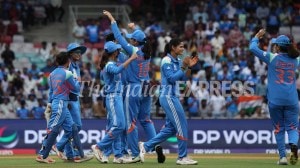India in Deepa’s aquarium
FEBRUARY 3: Andre Malraux, the wandering romantic, saw this in Benares: ``At this hour, Benares was the Ganges. A sparrow-hawk followed ou...

FEBRUARY 3: Andre Malraux, the wandering romantic, saw this in Benares: “At this hour, Benares was the Ganges. A sparrow-hawk followed our boat among the fires of the funeral pyres, constantly replenished, and the piles of wood for the cremations. Amid the swirling of the river, hemp-coloured like the city, a silent voice within me was quoting: `Here are the sacred waters of the Ganges, which sanctify the gaping mouths of the dead …’ The great prayer of India … rose from this multitude which for so many years had been greeting the same river and the same sun with the same hymn and with the same creations casually incinerating what the West calls life…”Sacred and dazzling, and this one a perfect piece from the collector of cosmic kitch. For optimum visual effect, let us update the script.
Place Shabana Azmi on the boat, amused sparrow-hawks hovering over her tonsured head. Let widows in transparent white crowd the banks of the Ganges, their simulated passion illuminated by the flames of the funeralpyres. O yes, it would be fantastic if some of the dead could emerge from the flames, in slow motion, reaching out to the widows, now taking a dip in the holy-dirty water, the voice of the narrator rising above the aquatic symphony: “Here are the sacred waters of the Ganges, which sanctify the gaping mouths of the audience…” Stillness, only to be seared by the howling of the trishul-wagging, torch-bearing, long-haired, bare-bodied men, worse than Mohicans, whose numbers multiply, whose feet trample over broken cameras, fallen crew members, wailing actresses … The colour of the Ganges turn saffron, one lonely sparrow-hawk circles above the wreckage.
Well, Deepa Mehta’s turbulent Water has brought two stereotypes together. The mad Hindu raging against blasphemy; and the culturally desperate artist looking for the Orientally exotic. The so-called waterphobic Hindus are no better than the mad mullahs who measure every book against the Book.
They are bad news for the religion as well as the party that isnot ashamed of being religious in the true conservative spirit. In a sense, they, the lunatic fringe steeped in scriptural paranoia, could be straight out of the Hindu India as panned by Mehta’s camera. For, Mehta’s elemental odyssey is nothing more than a cinematic alternative to poster art. Fiery lesbianism in Lajpat Nagar and Earthly romance in the time of Partition in Mehta’s mise en scenes are subjects vandalised by bad art. No, there is nothing wrong in artists seeking out lives from the back alleys of culture.
But the power of the subject alone cannot redeem the medium. But it can become a talking point in the marketplace of trends. Deepa Mehta, however creatively challenged she may be, is a successful filmmaker because she has chosen orientally trendy subjects to make pretty mediocre movies. The passage to India is internationally viable, but we are still waiting for a cultural passenger who can redeem India, an India where the metaphors are a bit more complex than the lesbian and the widow.
Sohow will you deal with a third-rate artist? Stone her to death? Ban the work and banish the artist? No. Even the bad artists should have the freedom of expression. There should be freedom in India to make bad movies.
Filmmakers like Mehta should not be elevated to the martyr’s gallery by misplaced protest. That would be the trivialisation of a legacy magnified by people like Solzhenitsyn and Rushdie, writers who suffered for imagining.
Mehta is not creatively qualified to join the ranks of writers and artists and filmmakers who have defied the reality managers. Poor Borges, who said “censorship is the mother of metaphor”. Look what is happening here: the desperate metaphor is pleading for censorship. Unfortunately, the scriptural police are always there to reward this desperation. Unfortunately, third-rate art can make first-rate cause.
Before Mehta, Tas-lima Nasreen, equally gifted, has achieved this. She wrote an immensely miserable novel and set off an honourable protest against the mullah’saesthetics. Does the waterphobia in Varanasi suggest that the mahant is catching up with the mullah, that the distance between the ghettos of Algiers and the ghats of Benares is shrinking? Actually Existing Islam, so remote from the ideal, not only echoed the fictional prophet of Rushdie: “Writers and whores. I see no difference here”. It has fixed a price for the deviant’s head. Rushdie is only the most visible victim. Remember the Egyptian writer Farag Fauda, who sought to separate Islam from realpolitik, and wept for a “great truth that has been distorted, for a great tradition that has been lost, and a great history that has been forgotten?” He was gunned down.
Or Nawal el-Saadawi, who has posed a dangerous question: “What is more harmful to the image of Islam than asking woman to show only half an eye, or shooting down thinkers with an automatic rifle?” She writes with a “guarded tongue”. There are many more examples of faith raging against threatening fantasy, of the idea of retributiontravelling from Hezbollah’s death cell to the writer’s study. Despite the argument of the Akbar Ahmeds and Edward Saids that the `Sword of Islam’ is a convenient stereotype manufactured by the West in the aftermath of the Cold War, the sword has been pretty active in setting the limits of dissent.
Is Islam fragile enough to crumble under a few pages of printed words, words as redeeming as Rushdie’s and as ridiculous as Taslima’s? Now the question is: Can Deepa Mehta’s water cannon kill Hinduism? Is Actually Existing Hinduism a fearsome travesty of the original? In terms of cultural intolerance, the term has not yet assumed the magnitude of Actually Existing Islam or Actually Existing Socialism. But a mad minority is capable of making the Hindu threat against ideas and art an international headline, especially at a time when a “Hindu nationalist party” is in power.
A perfect piece of antique intolerance from the land of snakecharmers and widow-burners. Perhaps the party and the Centre should havebehaveddifferently. They should have ignored Mehta and her script. By checking the script and issuing a no-objection certificate, the government has unknowingly legitimised the protest. As the protest has legitimised bad art and set off a good cause.
Beauty shall save the world, wrote Dostoevsky. The beauty of art, of imagination. In the back pages of history we read how ideology and religion have made beauty rhyme with blood. The banal from Deepa Mehta shall not save India and cinema. The madmen from Varanasi shall not save India and Hinduism.






- 01
- 02
- 03
- 04
- 05

























